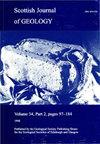苏格兰西北部Ratagain杂岩的混乱:从磁性结构分析中了解加里东花岗岩岩浆作用和侵位
IF 1.3
4区 地球科学
Q4 GEOLOGY
引用次数: 2
摘要
磁化率的各向异性(AMS)用于揭示明显各向同性的晶体岩性中微妙的矿物排列结构,包括花岗岩。这种岩质组构可以由与侵位有关的岩浆流动或侵位后构造应变产生。然而,仅通过现场观测来区分与流动有关的和构造组构可能具有挑战性,并且通常是一种广泛而武断的解释。在这篇文章中,我们采用了一系列的磁分析来表征苏格兰西北部c. 425 Ma Ratagain杂岩中岩石组构的起源,这是一个复合的晚加里东期花岗岩侵入岩。详细的磁分析表明,虽然所有侵入单元都带有环境构造套印,但重要的是,这并没有发展成一个明显的构造结构,并且包含一个水平缩短成分,表明了逆压作用。这似乎与公元前420-415 Ma以来明确的志留纪(加拿大期)区域张拉构造制度不一致。因此,我们认为,要么该复合体比以前认为的更年轻,要么它在最初就位后很长一段时间内以靠近岩浆固相的晶体糊状存在。该研究为进一步深入研究花岗岩侵入体的详细侵位机制、时间尺度和岩石成因奠定了基础,有助于认识晚加里东期构造。补充材料:本文的补充数据可在https://doi.org/10.6084/m9.figshare.c.5941375上获得主题集合:本文是早期职业研究集合的一部分,可在https://www.lyellcollection.org/cc/SJG-early-career-research上获得本文章由计算机程序翻译,如有差异,请以英文原文为准。
Mush ado about the Ratagain Complex, NW Scotland: insights into Caledonian granitic magmatism and emplacement from magnetic fabric analyses
The anisotropy of magnetic susceptibility (AMS) is used to reveal subtle mineral alignment fabrics in apparently isotropic crystalline lithologies, including granites. Such petrofabrics can be produced by emplacement-related magma flow or post-emplacement tectonic strain. However, discriminating between flow-related and tectonic fabrics using field observations alone may be challenging and is usually a broad and arbitrary interpretation. In this contribution, we employ a range of magnetic analyses to characterize the origin of the petrofabric in the c. 425 Ma Ratagain Complex, NW Scotland, a composite Late Caledonian granitic intrusion. Our detailed magnetic analyses reveal that whilst all intrusive units carry an ambient tectonic overprint, critically, this has not developed into an obvious tectonic fabric and contains a horizontal shortening component indicative of transpression. This appears at odds with the well-defined Silurian (Scandian phase) regional transtensional tectonic regime from c. 420–415 Ma onwards. Accordingly, we suggest that either the complex is younger than previously thought or that it existed as a crystal-mush close to the magmatic solidus for a protracted period after its initial emplacement. This study lays the foundations for much-needed further investigations into the detailed emplacement mechanisms, timescales and petrogenesis of individual granitic intrusions, to aid understanding of Late Caledonian tectonics. Supplementary material: Supplementary data to this article are available at https://doi.org/10.6084/m9.figshare.c.5941375 Thematic collection: This article is part of the Early Career Research collection available at: https://www.lyellcollection.org/cc/SJG-early-career-research
求助全文
通过发布文献求助,成功后即可免费获取论文全文。
去求助
来源期刊

Scottish Journal of Geology
地学-地质学
CiteScore
1.70
自引率
0.00%
发文量
10
审稿时长
>12 weeks
期刊介绍:
Although published only since 1965, the Scottish Journal of Geology has a long pedigree. It is the joint publication of the Geological Society of Glasgow and the Edinburgh Geological Society, which prior to 1965 published separate Transactions: from 1860 in the case of Glasgow and 1863 for Edinburgh.
Traditionally, the Journal has acted as the focus for papers on all aspects of Scottish geology and its contiguous areas, including the surrounding seas. The publication policy has always been outward looking, with the Editors encouraging review papers and papers on broader aspects of the Earth sciences that cannot be discussed solely in terms of Scottish geology.
The diverse geology of Scotland continues to provide an important natural laboratory for the study of earth sciences; many seminal studies in geology have been carried out on Scottish rocks, and over the years the results of much of this work had been published in the Journal and its predecessors.
The Journal fully deserves its high reputation worldwide and intends to maintain its status in the front rank of publications in the Earth sciences.
 求助内容:
求助内容: 应助结果提醒方式:
应助结果提醒方式:


